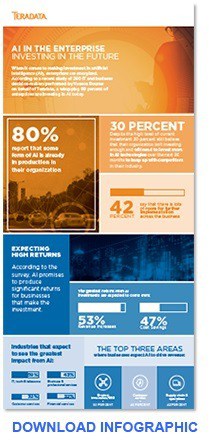
Businesses are spending on artificial intelligence, but, according to a recent study, the barriers and opportunities are so significant that they need a C-level position dedicated to AI strategy.
Enterprises are wise to the business value of artificial intelligence (AI). They are spending on it and see that it is a competitive necessity. However, business leaders also realize that challenges abound – challenges significant enough to call for a new executive in the c-suite to drive AI strategy, ensure adoption and measure return on investment (ROI).
Those are the findings of a new survey by market research firm Vanson Bourne, who conducted the study on behalf of Teradata, a company that specializes in the data and analytics.
The clear majority (80 percent) of 260 large organizations surveyed say they are investing in AI, but one in three business leaders report their company still must invest more over the next 36 months to keep pace with competitors.
While recognizing the competitive need to deploy AI, enterprises are anticipating significant barriers to adoption and are looking to strategize against those issues by creating a new C-suite position, the Chief AI Officer (CAIO), to streamline and coordinate AI adoption.
“Enterprises today see AI as a strategic priority that will help them outpace the competition in their respective industries,” says Atif Kureishy, vice president for Emerging Practices at Think Big Analytics, a Teradata company.
Kureishy added that to tap the potential of AI, businesses will to do more than invest in AI. They need to revamp core strategies so AI has an “embedded role from the data center to the boardroom.”
Enterprises have no issue investing in AI
While respondents are realistic about the challenges, they also have no hesitancy to spend and expect that investment to pay off — quickly. Enterprise leaders predict a 99 percent ROI in the next five years for every dollar invested today and 187 percent in ROI over the next 10 years.
Respondents expect to see the most impact from AI in the following industries:
- IT, technology and telecoms: 59 percent
- Business and professional services: 43 percent
- Customer services and financial services (tied): 32 percent
The three areas where businesses expect AI to drive revenue are product innovation/research and development (50 percent), customer service (46 percent) and supply chain and operations (42 percent). Not surprisingly, those also represent that top areas of AI investment listed by enterprises (listed below):
- Customer experience: 62 percent
- Product innovation: 59 percent)
- Operational excellence: 55 percent
Room for AI to grow
While 80 percent of respondents report that some form of AI is already in production in their organization, 42 percent say room (lots of room) exists for further implementation across the business. In fact, 30 percent say their organization isn’t investing enough and needs to budget for more AI technologies over the next 36 months to keep up with competitors in their industry.
Businesses are ready to spend on AI as both business and technology leaders anticipate cost- and time-savings, but they also cite a lack of IT infrastructure and shortage talent as barriers. Nine out of 10 respondents (91 percent) expect to see barriers to AI realization. One area business leaders aren’t worried about is the fallout of AI and automation on the workforce. Only 20 percent see this as a barrier.
Top concerns listed are as follows:
- Lack of IT infrastructure: 40 percent
- Lack of access to talent: 34 percent
- Lack of budget for implementation: 30 percent
- Complications around policies, regulations and rights: 28 percent
- Impact on customer expectations: 23 percent
Why CIOs and CTOs won’t drive AI strategy
CIOs and CTOs have been leading AI adoption and strategy. However, 62 percent of respondents say that AI is so critical to overall business practices that it calls for a C-level role dedicated to AI. They expect to hire a chief AI officer (CAIO) to take the AI reins and coordinate and mandate implementation throughout the enterprise.
Download this infographic that captures the key points of the Teradata/ Vanson Bourne research report.






























